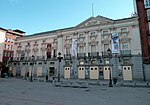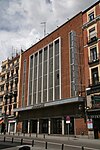Palace of Santoña (Madrid)
Bien de Interés Cultural landmarks in MadridBuildings and structures in Cortes neighborhood, MadridPalace stubsPalaces in MadridSpanish building and structure stubs

The Palace of Santoña (Spanish: Palacio de Santoña) is a palace located in Madrid, Spain. It was declared Bien de Interés Cultural in 1995.
Excerpt from the Wikipedia article Palace of Santoña (Madrid) (License: CC BY-SA 3.0, Authors, Images).Palace of Santoña (Madrid)
Calle de las Huertas, Madrid
Geographical coordinates (GPS) Address External links Nearby Places Show on map
Geographical coordinates (GPS)
| Latitude | Longitude |
|---|---|
| N 40.414019 ° | E -3.700365 ° |
Address
Palacio de Santoña
Calle de las Huertas 13
28012 Madrid (Centro)
Community of Madrid, Spain
Open on Google Maps










